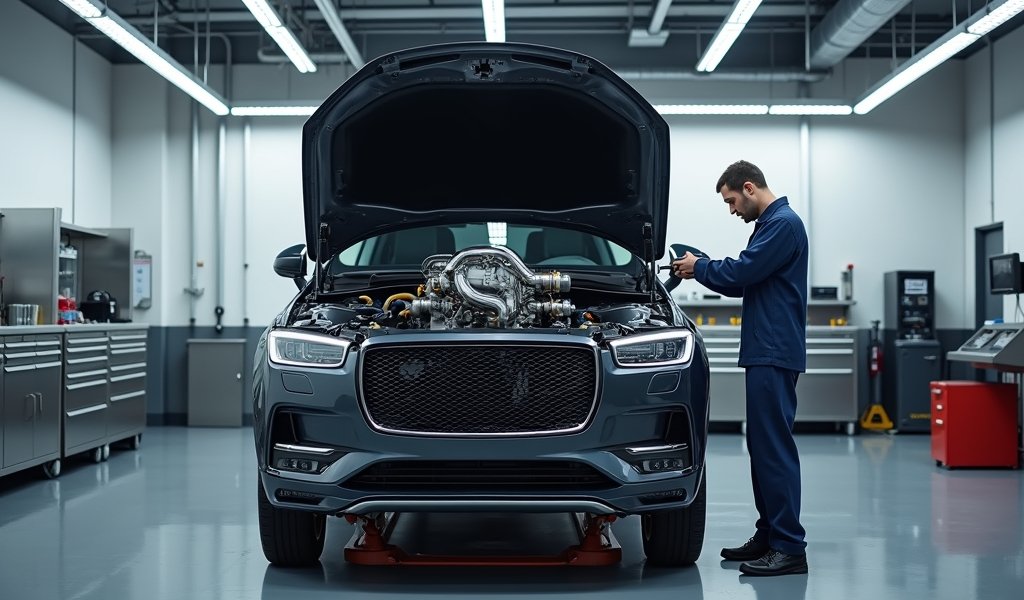Overview
This article provides five practical solutions to fix low boost pressure in turbo diesel engines: cleaning/replacing air filters, repairing boost leaks, maintaining wastegate actuators, addressing worn turbocharger components, and updating engine management software. Regular maintenance practices are essential for optimal boost pressure, and recognizing early warning signs can prevent more serious issues from developing.
Table of Contents
- Understanding Boost Pressure: The Heart of Your Turbo Diesel
- Fix #1: Clean or Replace the Air Filter
- Fix #2: Track Down and Fix Boost Leaks
- Fix #3: Inspect and Clean the Wastegate Actuator
- Fix #4: Address Worn Turbocharger Components
- Fix #5: Update Your Engine Management Software
- Ongoing Maintenance for Optimal Boost Pressure
- Conclusion: Restoring Your Turbo Diesel’s Power
- Frequently Asked Questions
Understanding Boost Pressure: The Heart of Your Turbo Diesel
Turbo diesel boost pressure might sound complicated, but it’s really the secret sauce that gives your diesel engine its punch. In my 20+ years working on diesels, I’ve seen firsthand how proper boost pressure transforms a sluggish truck into a torque monster.
Simply put, boost pressure is the extra air your turbocharger forces into the engine’s combustion chambers. This compressed air contains more oxygen molecules, allowing your engine to burn more fuel efficiently and create more power. Think of it as force-feeding your engine the air it craves.
When your turbo diesel has boost pressure problems, you’ll notice several telling symptoms:
- Significant power loss, especially when climbing hills or towing
- Black smoke billowing from your exhaust
- Higher fuel consumption with disappointing performance
- A noticeable “flat spot” during acceleration
- Illuminated check engine light or other warning indicators
The good news? Most boost pressure issues are fixable without breaking the bank. I’ve rescued countless diesels from underperformance using the five fixes I’m about to share with you. Let’s roll up our sleeves and get that boost back where it belongs.
Fix #1: Clean or Replace the Air Filter
I can’t tell you how many times I’ve seen dirty air filters rob perfectly good turbo diesels of their power. Your engine’s air filter is its first line of defense against airborne particles, but a clogged filter becomes a bottleneck that chokes your turbocharger.
How a Dirty Filter Kills Boost Pressure
Your turbocharger needs to move massive amounts of air to create proper manifold absolute pressure readings and boost. When your air filter becomes clogged with dust, pollen, and road debris, it restricts this airflow dramatically. This forces your turbo to work harder while delivering less air – a losing battle that results in lower boost pressure.
You can spot a dirty air filter by:
- Visible dirt and debris covering the filter material
- Discoloration from white/light color to dark gray or black
- Noticeable reduction in engine response
- Unusual engine sounds during acceleration
The Simple Fix That Makes a Big Difference
Cleaning or replacing your air filter is probably the easiest and most cost-effective boost pressure fix:
- Locate your air filter box (usually near the front of the engine bay)
- Remove the filter carefully, noting its orientation
- For paper filters, gently tap it against a solid surface to dislodge loose debris
- Hold it up to a light source – if light doesn’t pass through easily, it needs replacement
- For reusable filters, follow the manufacturer’s cleaning instructions
Most replacement filters cost between $15-50 and can be installed in minutes. According to a study by the Society of Automotive Engineers, a clogged air filter can reduce power by up to 11% in turbocharged engines. That’s significant power you can restore with a simple filter change!

Fix #2: Track Down and Fix Boost Leaks
A turbo diesel with boost leaks is like trying to inflate a bicycle tire with a hole in it – no matter how hard you pump, you’ll never reach full pressure. These leaks allow that precious compressed air to escape before it reaches your engine’s cylinders.
Common Leak Points You Should Check
After diagnosing hundreds of boost pressure issues, I’ve found that leaks typically occur in predictable places:
- Intercooler connections and hoses
- Rubber couplings that have deteriorated
- Charge pipe connections
- Turbo outlet flanges
- Intake manifold gaskets
- Cracked intercooler tanks (especially plastic ones)
Finding the Invisible Culprits
Boost leaks can be tricky to spot since they often occur under pressure. Here’s my tried-and-true detection method:
- With the engine cold, visually inspect all connections in the boost system
- Look for oil residue or black soot around joints (telltale signs of leaks)
- Mix dish soap with water in a spray bottle
- Spray the solution on suspected areas while the engine is running
- Watch for bubbles forming – that’s your leak!
For more stubborn leaks, I recommend using a smoke machine, which fills your intake system with visible smoke that escapes through any openings. Many auto parts stores rent these machines for reasonable rates.
Sealing Your System
Once you’ve found your leaks, fixing them is usually straightforward:
- Tighten loose clamps (but don’t overtighten and damage components)
- Replace cracked or hardened hoses and couplings
- Use high-temperature silicone for minor repairs
- Install new gaskets where needed
- Consider upgrading to higher-quality clamps for problem areas
I’ve seen boost pressure improve dramatically within minutes of sealing even small leaks. Remember, your turbo system needs to be completely sealed to develop proper boost. Even small leaks can have big consequences for performance.
Fix #3: Inspect and Clean the Wastegate Actuator
The wastegate is essentially the pressure relief valve for your turbocharger. When it’s working correctly, it opens at a specific pressure to prevent your turbo from over-boosting. When it’s not working right, your boost pressure becomes unpredictable – either dangerously high or frustratingly low.
Signs of Wastegate Problems
I can usually spot wastegate issues by these symptoms:
- Erratic boost pressure gauge readings
- Boost pressure that builds too slowly or too quickly
- Overboost conditions (can damage your engine)
- Boost that falls off suddenly under load
- Rattling noise from the turbo area
Getting Your Wastegate Working Properly
The wastegate actuator can become sluggish or stuck due to carbon buildup, corrosion, or vacuum issues. Here’s how to address these problems:
- Locate your wastegate actuator (typically mounted directly on the turbocharger)
- Check that the actuator rod moves freely
- Use carburetor cleaner to remove carbon deposits (be careful not to get cleaner on painted surfaces)
- Inspect vacuum lines for cracks or disconnections
- Verify that the actuator holds pressure when applied
For internal wastegates, you may need to remove the exhaust housing to properly clean the mechanism. This is more involved and might require special tools, so don’t hesitate to consult a professional if you’re not comfortable with the procedure.
Many modern diesel trucks use electronic actuators instead of vacuum-operated ones. For these systems, you’ll need to check electrical connections and possibly use a diagnostic scanner to verify proper operation.
Fix #4: Address Worn Turbocharger Components
Even the most durable turbochargers eventually wear out. After all, they’re spinning at up to 150,000 RPM under extreme heat and pressure. When turbo components wear, boost pressure suffers directly.
Warning Signs of Turbo Trouble
Here’s what to look for if you suspect your turbocharger is the culprit:
- Blue-gray exhaust smoke (indicates oil consumption)
- Whining or whistling noises that change with engine RPM
- Oil leaks around the turbocharger
- Significant power loss that other fixes haven’t resolved
- Bearing play in the turbo shaft
Common Failure Points
In my years of turbo repairs, I’ve found these components fail most often:
- Turbo shaft bearings (the most common failure)
- Damaged compressor or turbine wheels
- Clogged oil feed lines causing bearing starvation
- Failed seals allowing oil to enter the intake or exhaust
- Wastegate mechanisms built into the turbo
Rebuild or Replace: Making the Right Call
When facing turbocharger issues, you generally have three options:
- Rebuild your existing turbo: Costs typically range from $300-800 plus labor
- Install a new OEM turbocharger: The most expensive option ($800-2,500) but provides factory reliability
- Use a remanufactured turbocharger: A middle-ground option ($500-1,200)
For high-mileage diesel engines, I often recommend a quality rebuild or remanufactured turbo. The cost difference between these options and a new OEM unit rarely justifies the added expense unless you’re planning to keep the vehicle for many more years.
If you’re mechanically inclined, you might consider aftermarket turbo kits for cars that offer performance upgrades beyond stock specifications. Just be sure to research compatibility thoroughly.

Fix #5: Update Your Engine Management Software
Modern turbo diesels rely heavily on computer control for optimal boost management. Sometimes, the issue isn’t mechanical at all – it’s in the code.
When Software Needs an Upgrade
Your engine’s ECU (Electronic Control Unit) constantly adjusts boost pressure based on numerous factors. Over time, manufacturers often release updates to address known issues or improve performance. Here are signs you might benefit from a software update:
- Inconsistent boost pressure despite mechanical checks
- Poor throttle response or turbo lag
- Manufacturer service bulletins mentioning ECU updates
- Previous aftermarket modifications that may have affected the ECU’s baseline
- Check engine lights related to boost or MAP sensor readings
Factory vs. Aftermarket Tuning
You have two primary paths for software updates:
- Factory/Dealer Updates: These official updates focus primarily on reliability and emissions compliance. They’re the safest option for maintaining warranty coverage.
- Aftermarket Tuning: Specialized ECU remapping software can optimize boost control for better performance. This route typically provides more noticeable power increases but requires research to find reputable tuners.
The Rewards and Risks
Proper ECU tuning can deliver impressive benefits:
- More consistent boost pressure
- Elimination of “boost spikes” that strain components
- Improved throttle response and reduced lag
- Better fuel economy during normal driving
- Increased power output
However, there are important considerations:
- Overly aggressive tunes can reduce engine longevity
- Warranty implications for newer vehicles
- Potential emissions compliance issues
- Added stress on transmission and drivetrain components
According to DieselNet’s technical resources, modern diesel engine management systems are incredibly complex, integrating multiple control strategies that affect boost pressure. Professional tuning with proper equipment can safely optimize these parameters for your specific engine.
Ongoing Maintenance for Optimal Boost Pressure
As a diesel mechanic, I can tell you that prevention beats cure every time. Regular maintenance keeps boost pressure problems from developing in the first place.
Here’s my recommended maintenance schedule for turbo diesel owners:
- Air filter inspection every 5,000 miles, replacement as needed
- Boost leak check at the first sign of power loss
- Oil changes using the manufacturer-recommended oil weight and quality
- Turbo oil feed line inspection during oil changes
- Intercooler cleaning every 30,000 miles
- Comprehensive boost system inspection annually
Fuel Quality Matters
Don’t underestimate the impact of fuel quality on your turbo diesel’s performance. Lower-quality diesel can leave deposits throughout the fuel system and combustion chambers, affecting the efficiency of your turbocharger.
I recommend using fuel from reputable stations and periodically adding a quality diesel fuel treatment to keep injectors clean and combustion efficient. In cold climates, make sure you’re using winter-grade diesel or appropriate additives to prevent gelling.
When to Seek Professional Help
While many boost pressure issues can be tackled by DIY enthusiasts, some situations call for professional diagnosis:
- Complex diagnostic trouble codes related to boost pressure sensors
- Suspected internal engine problems
- Multiple symptoms occurring simultaneously
- When you’ve attempted the fixes above without success
- If you notice metal particles in your oil (indicating serious turbo damage)
Modern diagnostic equipment can pinpoint issues more precisely than ever before. Don’t hesitate to consult a diesel specialist if you’re facing persistent boost pressure problems.
Conclusion: Restoring Your Turbo Diesel’s Power
Proper boost pressure is the key to unlocking your turbo diesel’s full potential. By systematically addressing air filter restrictions, sealing boost leaks, maintaining wastegate function, addressing worn turbocharger components, and optimizing your engine management software, you can restore your diesel’s power, efficiency, and reliability.
Remember that most boost pressure problems develop gradually. Pay attention to subtle changes in your vehicle’s performance – that slight hesitation or reduced pulling power might be the early warning sign of a developing issue.
With the right approach and regular maintenance, your turbo diesel can continue delivering the power and efficiency you expect for many years to come. The satisfaction of feeling that proper boost kick in when you need it most makes all the effort worthwhile.
I hope these fixes help you get your diesel performing its best. There’s nothing quite like the confident pull of a properly boosting turbo diesel engine!
Frequently Asked Questions
What is normal boost pressure for a turbo diesel?
Normal boost pressure typically ranges between 8-22 PSI (0.5-1.5 bar) depending on your specific engine model and manufacturer specifications. Check your service manual for the exact specifications for your particular diesel engine.
Can low boost pressure damage my engine?
Low boost pressure itself doesn’t typically damage the engine, but it can cause poor combustion leading to carbon buildup and reduced efficiency. The underlying causes of low boost, however, might indicate problems that could cause damage if left unaddressed.
How can I test my turbo diesel’s boost pressure?
The most accurate way to test boost pressure is with a mechanical or digital boost gauge connected to the intake manifold. Many auto parts stores sell affordable boost gauge kits that temporarily connect to a vacuum line for testing.
Will a bigger turbo always create more boost?
Not necessarily. A larger turbo may create more potential airflow but often suffers from increased turbo lag and requires proper tuning to match the engine’s needs. Proper sizing and configuration matter more than simply installing a physically larger turbocharger.
Is black smoke always related to boost pressure problems?
Black smoke indicates incomplete combustion, which can be caused by boost pressure issues but also by faulty injectors, incorrect timing, or air filter restrictions. It’s a symptom that should prompt investigation of the fuel and air systems together rather than assuming it’s exclusively a boost problem.


Pingback: Turbo Variable Geometry Actuator 5 Fixes - knowsyourcar.com